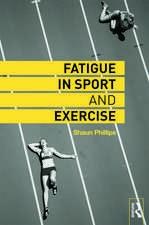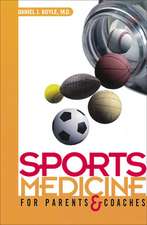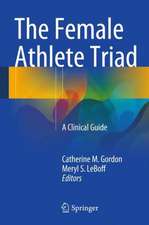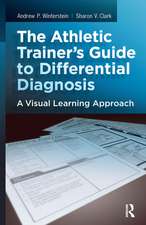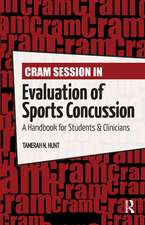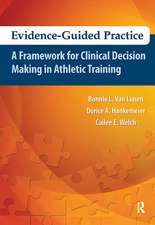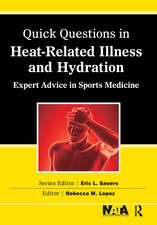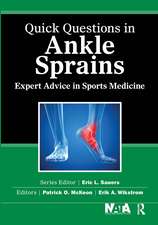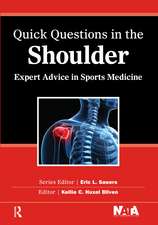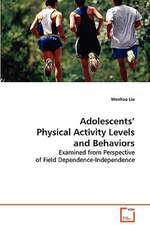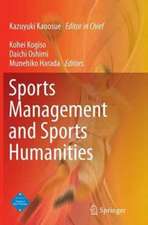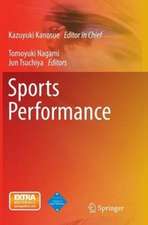Sports Injuries and Prevention
Editat de Kazuyuki Kanosue, Tetsuya Ogawa, Mako Fukano, Toru Fukubayashien Limba Engleză Hardback – 21 iul 2015
The book is composed of seven parts. In the beginning part, current situations and the general characteristics of sports-related injuries are outlined on the basis of an investigation utilizing statistical data involving a large number of populations. In the following parts, detailed information on the injuries in terms of the types of sports activities, body sites, symptoms and the relationships among these factors are discussed. Part 2, for example, deals with topics on concussion and severe head–neck injuries which occur frequently in rugby and judo. In Parts 3 and 4, as one of the major sports-related injuries, anterior cruciate ligament (ACL) injuries are discussed. Beginning with the underlying mechanisms as assessed by using the latest measuring techniques, characteristic features of their occurrence are described. Further, Part 4 deals with topics on post-operative (ACL reconstruction) aspects of ACL injuries, especially those related to muscle functions and tendon regeneration in the hamstring muscles. Part 5 deals with muscle strain and focuses particularly on those occurring in the hamstring muscles, as this muscle group is known, as one of the most frequent sites of muscle strain. In Part 6, disorders related to the ankle and foot are introduced. Finally, Part 7 provides information on lower back disorders. Included are detailed mechanisms of their incidence, epidemiology and implications for their prevention.
Preț: 1021.48 lei
Preț vechi: 1075.24 lei
-5% Nou
195.48€ • 212.27$ • 164.21£
Carte tipărită la comandă
Livrare economică 18-24 aprilie
Specificații
ISBN-10: 4431553177
Pagini: 250
Ilustrații: XIV, 413 p. 169 illus., 72 illus. in color.
Dimensiuni: 155 x 235 x 25 mm
Greutate: 0.97 kg
Ediția:1st ed. 2015
Editura: Springer
Colecția Springer
Locul publicării:Tokyo, Japan
Public țintă
ResearchCuprins
Recent statistics on sports injuries in Japan.- Types of sports injuries.- Mechanisms and risk factors underlying sports injury.- Possible intervention method for injury prevention.- Result of intervention and the efficacy of the prevention program.
Recenzii
Textul de pe ultima copertă
This book presents the incidence of sports-related injuries, the types of injuries specific to particular sports, and the importance of factors such as age and gender. Possible injury mechanisms and risk factors are presented based on an analysis involving recent scientific findings. A variety of sports are included to allow the reader to better generalize the results as well as to apply appropriate procedures to specific sports. The authors have emphasized basic scientific findings to help the reader gain a broad knowledge of sports injuries. The potential audience includes medical doctors, physical therapists, athletic trainers, coaches, and interested parents. This book is expected to play a prominent role in the construction of training programs for both healthy and injured players. The focus on junior athletes will aid in their education, injury prevention, and increased performance. It will also benefit instructors at the junior and senior high school levels.
The book is composed of seven parts. In the beginning part, current situations and the general characteristics of sports-related injuries are outlined on the basis of an investigation utilizing statistical data involving a large number of populations. In the following parts, detailed information on the injuries in terms of the types of sports activities, body sites, symptoms, and the relationships among these factors are discussed. Part 2, for example, deals with topics on concussion and severe head–neck injuries which occur frequently in rugby and judo. In Parts 3 and 4, as one of the major sports-related injuries, anterior cruciate ligament (ACL) injuries are discussed. Beginning with the underlying mechanisms as assessed by using the latest measuring techniques, characteristic features of their occurrence are described. Further, Part 4 deals with topics on post-operative (ACL reconstruction) aspects of ACL injuries, especially those related to muscle functions and tendon regeneration in the hamstring muscles. Part 5 deals with muscle strain and focuses particularly on those occurring in the hamstring muscles, as this muscle group is known, as one of the most frequent sites of muscle strain. In Part 6, disorders related to the ankle and foot are introduced. Finally, Part 7 provides information on lower back disorders. Included are detailed mechanisms of their incidence, epidemiology, and implications for their prevention.
Caracteristici
Focuses on knee ACL injuries, head and neck injuries (including concussion) and muscle strain
Sets forth detailed physical programs for preventing injuries among junior athletes
Descriere
This book presents the incidence of sports-related injuries, the types of injuries specific to particular sports, and the importance of factors such as age and gender. Possible injury mechanisms and risk factors are presented based on an analysis involving recent scientific findings. A variety of sports are included to allow the reader to better generalize the results as well as to apply appropriate procedures to specific sports. The authors have emphasized basic scientific findings to help the reader gain a broad knowledge of sports injuries. The potential audience includes medical doctors, physical therapists, athletic trainers, coaches and interested parents. This book is expected to play a prominent role in the construction of training programs for both healthy and injured players. The focus on junior athletes will aid in their education, injury prevention and increased performance. It will also benefit instructors at the junior and senior high school levels.
The book is composed of seven parts. In the beginning part, current situations and the general characteristics of sports-related injuries are outlined on the basis of an investigation utilizing statistical data involving a large number of populations. In the following parts, detailed information on the injuries in terms of the types of sports activities, body sites, symptoms and the relationships among these factors are discussed. Part 2, for example, deals with topics on concussion and severe head–neck injuries which occur frequently in rugby and judo. In Parts 3 and 4, as one of the major sports-related injuries, anterior cruciate ligament (ACL) injuries are discussed. Beginning with the underlying mechanisms as assessed by using the latest measuring techniques, characteristic features of their occurrence are described. Further, Part 4 deals with topics on post-operative (ACL reconstruction) aspects of ACL injuries, especially those related to muscle functions and tendon regeneration in the hamstring muscles. Part 5 deals with muscle strain and focuses particularly on those occurring in the hamstring muscles, as this muscle group is known, as one of the most frequent sites of muscle strain. In Part 6, disorders related to the ankle and foot are introduced. Finally, Part 7 provides information on lower back disorders. Included are detailed mechanisms of their incidence, epidemiology and implications for their prevention.

